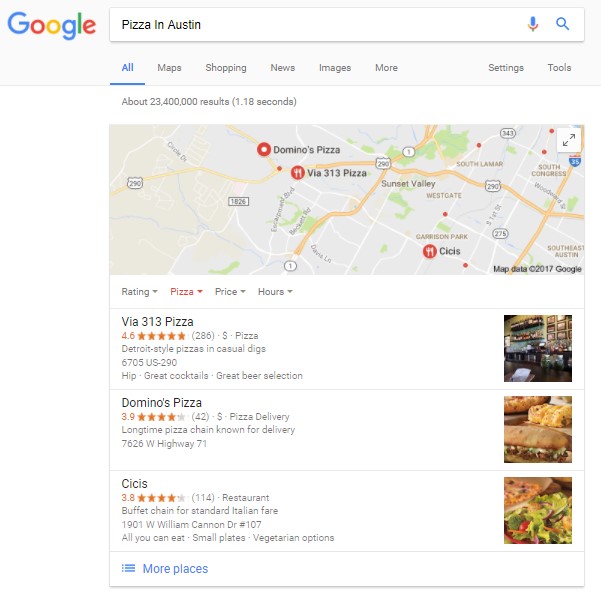By Tommy Landry, CEO & President, Return On Now
For businesses that serve one or more local markets as their primary focus, Local SEO can make a massive impact on your foot traffic and revenue. This is why we have so many vendors who focus strictly on driving Local SEO success.
Many small business owners, however, have misconceptions about what Local SEO is, how it works, and whether or not they can do it themselves. While it’s true that you can make a move faster by bringing in a trained professional, we can’t all afford to pay the big dollars to speed up the process.
Many small businesses are cash and time strapped, which are polar opposite constraints on their ability to manage this themselves. Before you made a decision on how to handle your own Local SEO, take time to understand exactly what it is in the first place. Only then can you make the right decision on how to proceed for the best of your business and your budget.
So let’s start out with the basics…
What is Local SEO?
In its simplest form, Local SEO encompasses everything you do to show up in your local market on Google and other search engines. With Google owning nearly 70% of the search market these days, we will spend most of our time looking at how to rank locally on Google.
We often get questions such as, “How do I rank in the local market?” That is a very broad question, and there are really two ways to do so – the natural organic listings, and the Local Pack or Google Maps listing.
These two types of listings on Google are driven by completely disparate ranking algorithms. That’s right, Google isn’t run off one single ranking and logic approach. For local, there are two.
Natural Organic Listings
The Natural Organic Listings as we call them are simply how Google ranks your website among all of the other websites that are relevant to whatever the user searched for. So if you run a pizza shop in Austin, you’d be aiming to rank for something like “Austin pizza shop” or “best pizza in Austin.”
The Organic listings are managed very similarly to how one would manage SEO for a national brand. It requires all of the same items such as where and how you use keywords on the website itself (on-page or on-site SEO), who links to you (off-page SEO), and how well built your site is for ease of use, search engine indexing, and performance (technical SEO).
There is one small difference – you’ll be focusing on ranking for terms that include the name of your city, country, or whatever geographic area you serve. We will dig into the actual “ranking factors” as we call them later in this post.
Local Pack and Google Maps
The local rankings are a completely separate algorithm, i.e. system of ranking. This is what drives things like whether or not your business shows up on Google Maps – which is a must have if you want people to be able to find your physical location via Google and other apps that provide driving directions.
Perhaps the most important part of this local algorithm is what we refer to as the local pack. The local pack is the shorter list of 3-7 businesses in your vicinity that you see toward the top of the Google SERPs (Search Engine Ranking Pages) after you do a search. Below you can see what the local pack looks like for reference.

If you use Google, particularly on a mobile device, you’ve certainly seen a similar view to the above. It’s a huge boon to your business to appear among the top three businesses in this pack.
Note that you can click the “More places” link at the bottom to get a longer list. That’s not a terrible thing to achieve, since most people will click that link if they don’t see anything among the top three that meets their needs.
Ranking Factors for Local SEO
Now that we’re all on the same page about what the two algorithms are and what they mean, let’s look at what it takes to show up in each place. As I mentioned earlier, we refer to these items as “Ranking Factors,” and there are quite a few you should understand – no matter if you want to manage it yourself or bring in someone to do it for you.
Local Organic Ranking
As with all organic rankings, there are some tried and true techniques to enhance your chances of ranking as a whole. The difference here is that you will want to start including location in your choice of keywords and sites to earn links from.
Let’s look at the some of the top factors according to the industry experts at Moz.com:
- Links: As the clear winner for most important ranking factor, links from other websites pointing at your own domain are crucial to ranking on the first page of Google for just about any keyword or search term. Aim to select link targets that focus locally or will be talking about a local topic if possible.
- On-Page: Which keywords you select (look for keyword that fewer websites are pursuing to make it easier) and where you put them on the website is a close second to links for local ranking. Be sure to include the city or locale you target in the content and other page items such as image names, page titles, and sub-headings whenever you can. Don’t overdo it, though. Keyword stuffing can actually hurt you with today’s algorithms.
- User Behavior: Your ranking can improve or give back spots depending on the click-thru rate from your listing to your website, how many mobile users use “click to call,” how long visitors stay on your website after they do click on it, and even how may check-ins visitors make at your physical location.
- Citations: This relates specifically to local directories. Your NAP (Name / Address / Phone) information needs to be identical across the various local directories, and especially the 80-100 sites that Google uses to verify your location. Make sure you’re listing in the right places with the exact same information, and it will help you rank better for local search terms.
- Google My Business: Is your business listed on Google My Business? For local-targeted products and services, it’s a must-have. How you appear on their own platform impacts your organic rankings and is a prerequisite to making it onto Google Maps (oops, just stole my own thunder for later!).
- Reviews: Reviews play an important role in whether or not you rank ahead of competitors. Although it’s a smaller component of the natural organic rankings, it does come into play. Get those reviews.
- Social Media Engagement: Do you have social media profiles for your business? If so, make sure you use them for not only mass spamming out offers and company news. Your local ranking depends on users engaging with your posts and updates. So make it good!
Local Pack and Google Maps Ranking
You’ll note that many of the ranking factors are duplicated across the two platforms. The difference comes down to which impact your ranking more within each algorithm.
For the local pack and Google Maps side of the equation, here are the ranking factors in order of importance. As you can see, different items have different effects.
- Google My Business: As not only a prerequisite for the local pack, Google My Business is also very important at driving which categories and area you’ll show up in. This is particularly important for mobile, as Google uses the location of the device to serve up nearby businesses dynamically. Think about it – isn’t it ideal for you to jump to #1 for a search made a half block from your retail storefront? Google My Business is the engine behind you benefitting from that feature in the local ranking algorithm.
- Links: Links are the second most important for this “other” algorithm, with local links being even more important as well as links that use the location in the anchor text (the words that are clickable within the hyperlink itself, typically underlined and colored blue or another color to match the website).
- On-Page: All of the same on-page requirements remain relevant for the local pack and maps. For an added boost, it pays to have semantic markup added to your website that tells the search engines which part of your content is the physical address for which you want to rank. Make sure it is precisely the same as on My Business and your local directories.
- Citations: Even more important for the second algorithm. If you don’t have time to manage 75+ directory listings, bring in a Local SEO provider or hire a listing aggregator like Yext or Moz Local to do it for you.
- Reviews: Reviews drive your placement in the local algorithm. You will also notice that the average ratings show up as stars on the local pack, so aim for those 4- and 5-star reviews on Google My Business for maximum positive impact.
- User Behavior: Same as above – if users enjoy the experience of interacting with your website after they click through to it from Google, it will help you maintain or earn higher rankings in the local algorithm.
- Social Media Engagement: Social media is the only factor that has almost the same exact impact on both algorithms. It’s a very small percent of your overall success on both, but still worth getting right nonetheless. Just get all of the above in order first to be sure you’re as well positioned as possible.
Summary
Local SEO can provide tremendous benefit to your company if you manage it correctly. You should now have enough information to make the call on whether to do it yourself, or bring in a professional to help you get it all in order. Now go out there and earn those local customers!
As CEO and President of Return On Now, Tommy Landry provides the vision behind the company’s SEO and SEM methodologies. With over 25 years of business experience and a deep understanding of modern internet marketing techniques, he spends his time providing hands-on consulting, insightful content, and engaging public speaking appearances to Online Marketers of all skill levels.

